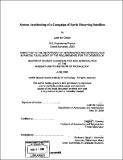| dc.contributor.advisor | Edward F. Crawley. | en_US |
| dc.contributor.author | Colson, Justin M | en_US |
| dc.contributor.other | Massachusetts Institute of Technology. Dept. of Aeronautics and Astronautics. | en_US |
| dc.date.accessioned | 2009-04-29T17:16:35Z | |
| dc.date.available | 2009-04-29T17:16:35Z | |
| dc.date.copyright | 2008 | en_US |
| dc.date.issued | 2008 | en_US |
| dc.identifier.uri | http://hdl.handle.net/1721.1/45260 | |
| dc.description | Thesis (S.M.)--Massachusetts Institute of Technology, Dept. of Aeronautics and Astronautics, 2008. | en_US |
| dc.description | Pages 183 and 184 blank | en_US |
| dc.description | Includes bibliographical references (p. 180-182). | en_US |
| dc.description.abstract | Given the current level of concern over anthropogenic climate change, and the ongoing debate worldwide regarding what action should be taken to reduce and reverse future warming, the ability to collect data on Earth system dynamics is of high importance. This thesis discusses how systems architecture principles can be successfully applied to the scheduling and implementation of large, complex space satellite systems, designed to provide measurements towards the understanding of these Earth dynamics. These systems are extremely complex, making them difficult to deconstruct and analyze using commonly used campaign planning methods. This thesis presents the development of software models that successfully generate thousands of campaign architecture concepts for the complex satellite system. Through the use of value function and decision metrics, this set of feasible architectures can be evaluated and ranked. This ranking produces recommendations on how to down-select to a handful of favorable concepts to be carried forward for more detailed study and development. Furthermore, the document presents a method of connecting the scheduling and sequencing problem with the design of individual sensors within the satellite system. This thesis showcases many of these complex scheduling examples, providing recommendations on how to plan an Earth observing system of satellites under a variety of design constraints. Through the inclusion of additional climate objectives, other previously planned missions are forced to be removed from the schedule. With these new measurement objectives, this document provides recommendations on how to plan under various budget constraints. | en_US |
| dc.description.abstract | (cont.) Ultimately, simply planning with an emphasis on climate change measurements is not enough to produce a solution that satisfies all stakeholder needs. Increasing campaign budget so that more missions execute may be necessary to gather sufficient measurements for further understanding the Earth's global system dynamics. | en_US |
| dc.description.statementofresponsibility | by Justin M. Colson. | en_US |
| dc.format.extent | 184 p. | en_US |
| dc.language.iso | eng | en_US |
| dc.publisher | Massachusetts Institute of Technology | en_US |
| dc.rights | M.I.T. theses are protected by
copyright. They may be viewed from this source for any purpose, but
reproduction or distribution in any format is prohibited without written
permission. See provided URL for inquiries about permission. | en_US |
| dc.rights.uri | http://dspace.mit.edu/handle/1721.1/7582 | en_US |
| dc.subject | Aeronautics and Astronautics. | en_US |
| dc.title | System architecting of a campaign of earth observing satellites | en_US |
| dc.type | Thesis | en_US |
| dc.description.degree | S.M. | en_US |
| dc.contributor.department | Massachusetts Institute of Technology. Department of Aeronautics and Astronautics | |
| dc.identifier.oclc | 310367385 | en_US |
